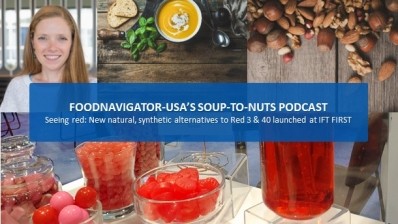California bans common food dyes in schools days after FDA, stakeholders discuss proposed systematic post-market review process for chemicals in foods

Over the weekend, California Gov. Gavin Newsom signed into law the California School Food Safety Act, which bans Red Dye No. 40, Yellow Dyes No. 5 and No. 6, Blue Dyes No. 1 and No. 2 and Green Dye No. 3 from food served in the state’s public schools beginning Dec. 31, 2027.
Unless reformulated, some sports drinks, juices and sodas as well popular snacks, like Hot Cheetos, Doritos and M&M’s, currently available in California schools could no longer be sold in California schools after the ban goes into effect.
Consumer advocates, including the Environmental Working Group, the Center for Science in the Public Interest and Consumer Reports, laud the first-of-its-kind legislation and encourage other states to follow suit and ask FDA to add warning labels on dye-containing foods, as the European Union did in 2010.
Other food safety experts worry the passage of California Assembly Bill 2316 reinforces a “dangerous precedent” set in part by California a year ago when Newsom signed into law the California Food Safety Act, which prohibits the manufacture, sale and distribution of foods for human consumption in the state containing brominated vegetable oil, potassium bromate, propylparaben or Red Dye No. 3. That legislation began a domino effect among other states, including Illinois, Missouri, New York and Washington, seeking similar prohibitions.
The bill’s passage came days after FDA hosted a public meeting at its White Oak Campus to layout a proposed systematic process for post-market review of chemicals used in foods, which the stakeholders gathered lauded as a step in the right direction but simultaneously criticized for being “thin on details.”
A domino effect: How will the bill’s passage impact other state, federal and business actions?
The impetus for the California School Food Safety Act, authored by Assemblymember Jesse Gabriel, D-Encino, and co-sponsored by EWG and Consumer Reports, are concerns that synthetic dyes could “cause or worsen hyperactivity, inattentiveness and other behavior problems in children,” CSPI explained in a statement supporting the bill’s passage.
For support, it pointed to a 2021 report by California’s Environmental Protection Agency following a multi-year comprehensive assessment that suggested dyes – including those in the legislation – could harm the “academic and social success” of “sensitive children.”
“Kids deserve wholesome foods that enhance their learning rather than detract from it, and parents need to feel confident schools are offering meals that are both safe and nutritious,” added EWG Senior Scientist Tasha Stoiber in a statement.
EWG also criticized FDA for not reevaluating the dyes in the legislation. It notes FDA last evaluated Red 40 in 1971, Yellow 5 in 1969, Yellow 6 in 1986, Blue 1 in 1969, Blue 2 in 1983 and Green 3 in 1982.
“I hope that the overwhelming bipartisan support for this new law will encourage the federal government to take a more proactive role in protecting Americans from dangerous chemicals in our food supply,” Assemblymember Gabriel said in a statement.
He added that bipartisan passage of the legislation “sends a strong message to manufacturers to stop using these harmful additives.”
FDA stands by safety of dyes even as it modernizes its post-market review process
FDA repeatedly has reiterated the safety of approved dyes, including in a consumer update posted late last year that said color additives are safe when used in accordance with regulations.
But, it added it “continually monitors reports of problems that may be related to color additives and takes action when necessary.”
The agency’s process for reviewing dyes and other food chemicals post-market has come under the microscope in recent years – spurring the agency to take a more formal approach.
“We have not had a robust post-market safety review program here at FDA … largely because there is no statutory requirement for FDA initiated post-market review or for the industry to conduct safety testing and share that data with FDA after a chemical is introduced into the market,” Jim Jones, FDA Deputy Commissioner for the newly formed Human Foods Group, said last week at a public meeting hosted by the agency.
However, he added, FDA is “modernizing our approach to post market chemical safety assessments, because we as a society have learned much about chemical safety over the past several decades, and in response to growing public demand for the FDA to do more to ensure the safety of chemicals currently in the US food supply.”
While he acknowledged state’s rights to regulate the food supply within their borders, including banning specific chemicals, he argued, “a strong national food safety system is not built state by state. The FDA must lead the way on food chemical safety.”
He added the agency intends to implement its updated post-market safety review process by the end of 2025.
Other food safety leaders echoed Jone’s sentiment, including former FDA Deputy Commissioner, Food Policy & Response, Frank Yiannas, who responded to the passage of AB 2316 earlier this week.
“While these actions are well-intended, they continue to set dangerous precedents on how food safety standards in our nation are best established,” he said in a LinkedIn post.
He added, “We need strong, science-driven, federal food safety leadership. Without it, our country is increasingly left with a state-by-state patchwork of different, emerging regulatory standards that will, in my view, ultimately weaken our nation’s food system – not strengthen it.”
The International Food Additives Council agreed, adding that "state-specific legislation like the California School Food Safety Act (AB2316) are undermining the U.S Food and Drug Administration (FDA), the primary agency responsible for ensuring the safety of our nation's food supply. This legislation is not only misguided, but it also increases costs and complexity, ultimately affecting the population that needs nutrition the most while disrupting national food regulations and causing consumer confusion. This approach fosters unnecessary fear and mistrust in the federal system. IFAC supports the FDA's mission to protect public health and believes that a unified, federal approach is essential for maintaining a safe and reliable food supply."
Innovative color alternatives support reformulation efforts
With the clock now ticking to reformulate products with the dyes in the School Food Safety Act as well as the ingredients listed in the California Food Safety Act that passed last year, ingredient suppliers are actively innovating and promoting alternatives.
For example, color experts at Roha, Givaudan, Lycored and California Natural Colors promoted at an industry event this summer new and existing natural and synthetic alternatives to the dyes and titanium dioxide targeted by state legislation and public health advocates.
In an episode of FoodNavigator-USA’s Soup-To-Nuts podcast recorded at the Institute of Food Technologists’ annual Food Improved by Research, Science and Technology (IFT FIRST) conference and expo in Chicago in July, they also shared factors that could influence manufacturers’ reformulation decisions, including intensity, applications, shelf life stability, the potential for off notes, cost and broader market trends, including a move towards clean label and increased price sensitivity.





















